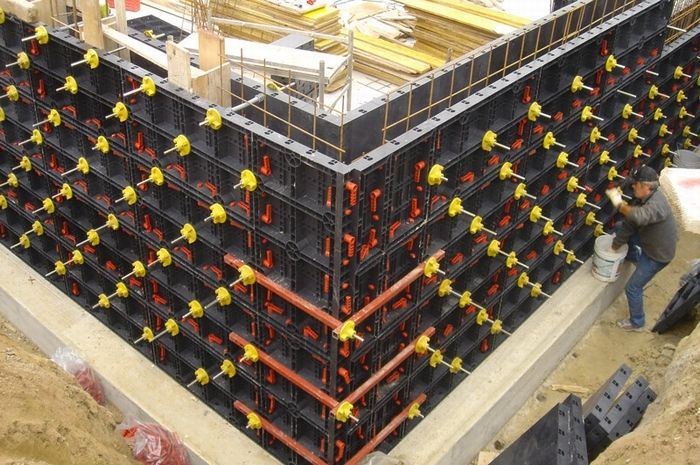The possibility of formwork reuse is determined by the type of formwork and the nature of construction. Reusing concrete formwork can reduce construction costs significantly if proper planning and handling is applied.
Formworks are molds where concrete in its plastic form is poured so that it can be molded into the desired shape, size, position, and more importantly, its alignment, when it become solid concrete. Materials used for formwork construction range from timber, steel, and aluminum to glass–reinforced plastics.

Types of Formwork and Reusability
Formwork made out of wood is widely used in construction. The wood formwork system is a combination of lumber and plywood. Plywood is also known as “sheathing” in the formwork system and is used as a supporting layer of formwork in direct contact with the concrete. It is made from thin sheets of wood, called veneer, glued together under intense heat and pressure. Wood formwork has a limited number of reuses compared to other materials of formwork.
Steel and aluminum formwork is used mainly due to its capability to carry heavy concrete, provide longer spans, and having good potential for reuse. They are often more favorable over wood formwork because it is a lot easier and faster stripping a steel or aluminum formwork than wood formwork from concrete. The main differences between steel and aluminum formwork are their weight and cost. Steel formwork costs more and is heavier than aluminum formwork.
Glass-reinforced plastic made for formwork is a fiber reinforced polymer (FRP). It is a material of high strength and still lightweight. Glass-reinforced plastic formwork is useful for structural concrete elements that have complex shapes and unique features. It is easy to disassemble and has a capability for a high number of reuses.
The reusability of formwork also depends on the nature of the construction. The more symmetrical and repetitive the structural element layout is, the more favorable formwork reuse is. Complicated structural elements such as curved concrete beams or any irregularly shaped concrete structure may require custom made formwork, which does not favor formwork reuse.
Formwork materials must be handled carefully and accidental dropping must be avoided as possible. Used formwork panels should be inspected for damage before they are used again. Formwork highly affects the final appearance of the finished structure, so any defect must be checked first and repaired or removed; otherwise the formwork defect will reflect on the finished surface of the concrete. After the formwork is repaired, any excessive concrete on the formwork surface must be removed also. Aluminum formwork should be oiled to prevent it from getting rusty. After the used formwork is repaired, excessive concrete removed and oiled, they should be stockpiled and covered with suitable fabric like canvas.
Reusing Formwork Saves in Construction Costs
Formwork is a large proportion of the total cost of a building structure, approximately 10 percent of total cost of the structure. Reusing formwork for concrete is one of the ways to reduce construction costs. The initial cost of formwork materials will drop to 40 percent after five reuses. The economical value or reusing formwork lies in the ease with which it can be stripped from concrete. With that in mind, formwork designers must kept abreast in advancing technology of formwork manufacturing so that quality can be maintained without ignoring its economical value in facing new challenges in reusing concrete formwork.



Comments are closed